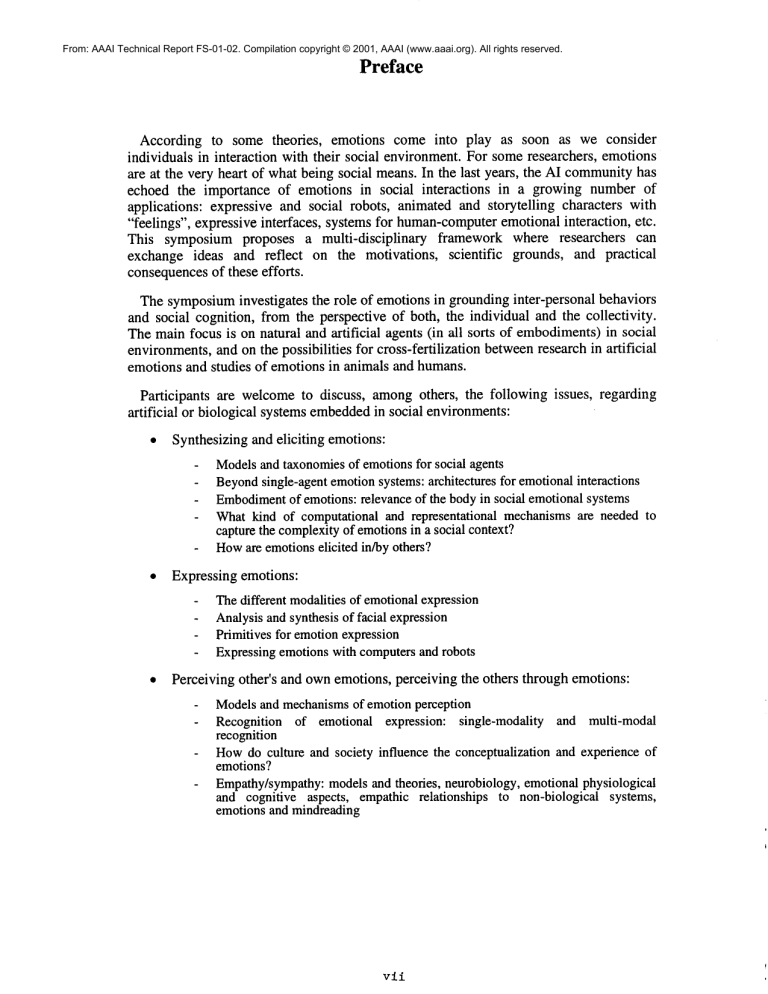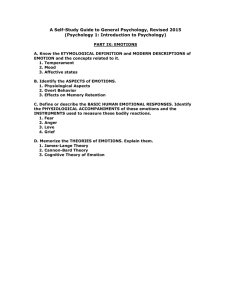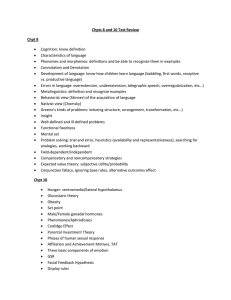
From: AAAI Technical Report FS-01-02. Compilation copyright © 2001, AAAI (www.aaai.org). All rights reserved.
Preface
According to some theories,
emotions come into play as soon as we consider
individuals in interaction with their social environment. For some researchers, emotions
are at the very heart of what being social means. In the last years, the AI communityhas
echoed the importance of emotions in social interactions
in a growing number of
applications: expressive and social robots, animated and storytelling characters with
"feelings", expressive interfaces, systems for human-computeremotional interaction, etc.
This symposium proposes a multi-disciplinary
framework where researchers
can
exchange ideas and reflect on the motivations, scientific
grounds, and practical
consequencesof these efforts.
The symposiuminvestigates the role of emotions in grounding inter-personal behaviors
and social cognition, from the perspective of both, the individual and the collectivity.
The main focus is on natural and artificial agents (in all sorts of embodiments)in social
environments, and on the possibilities for cross-fertilization betweenresearch in artificial
emotions and studies of emotions in animals and humans.
Participants are welcometo discuss, amongothers, the following issues, regarding
artificial or biological systems embeddedin social environments:
Synthesizing and eliciting emotions:
-
Modelsand taxonomiesof emotionsfor social agents
Beyondsingle-agent emotionsystems: architectures for emotionalinteractions
Embodiment
of emotions: relevance of the bodyin social emotional systems
Whatkind of computational and representational mechanismsare needed to
capture the complexityof emotionsin a social context?
Howare emotionselicited in/by others?
Expressing emotions:
¯
Thedifferent modalities of emotionalexpression
Analysisand synthesis of facial expression
Primitives for emotionexpression
Expressing emotions with computersand robots
Perceiving other’s and ownemotions, perceiving the others through emotions:
-
Modelsand mechanismsof emotion perception
Recognition of emotional expression: single-modality and multi-modal
recognition
Howdo culture and society influence the conceptualization and experience of
emotions?
Empathy/sympathy:
modelsand theories, neurobiology, emotional physiological
and cognitive aspects, empathic relationships to non-biological systems,
emotions and mindreading
vii
¯
Developmental perspective:
-
¯
Influence of society and culture on emotionaldevelopment
Cross-cultural aspects
Therole of emotionsin the development
of social interactions/relationships
Therole of social interactions/relationships in the development
of emotion
Genes, intelligence and behavior: The molecular basis of intelligence and
emotion
Emotionsin the formationof personality and inter-subjectivity
Intra- and inter-individual regulation in social interactions:
Regulationof individual behavior by emotionsin a social context
Regulationof social interactions by emotions
Regulationof emotionsin social interactions
Emotionas a motivationmechanismin driving social interaction
Emotion,motivation, and attention: their combinedroles in interactions
Emotions,adaptation, and learning: emotion-driven learning and adaptation in
social contexts, emotionsin social learning
Machiavellianaspects of emotions: manipulationand control, politics, emotions
in artistic andscientific practice
The artifact in the loop: howdo computersand robots influence emotions and
emotionalinteractions?
¯
Origins, evolution, and emergence of emotional phenomena:
Doemotionshave a social origin, and in what sense?
Theevolution of emotionsin natural and artificial societies
Computational models of emergent emotion-related phenomena
¯
Emotions, communication, and language:
Whatdo emotions communicateto others?
Modulation of communicationby emotions
Analysis and synthesis of affective componentsin speech
The role of motivation and emotion in the origins and evolution of (proto-)
language
Expressionand description of emotionsin natural and artificial languages
¯
Emotional disorders:
Howdo they affect social interaction?
Artificial models (software and robotics) of clinical disorders involving
emotionaland/or social dysfunctions
Relationshipsbetweenemotion-relatedand other clinical disorders
Social and emotionalinteractions in therapy
¯
Philosophy:
Relation betweenemotionand sociality
The embodiment
of emotions: is the emotional body a social body?
Emotionsand sociality in the philosophicaltradition
viii
-
Epistemologicalissues
Ethical aspects
Applications:
arts, believable and synthetic agents, control mechanisms
for autonomous
agents,
coordination and negotiation, education, entertainment, human-computer
interaction, interfaces, medicine and therapy, multi-agent systems, pets and
personal robots, interactive virtual reality, wearablecomputing,etc.
Researchers from multiple disciplines (e.g., AI, arts, biology, ethology, humanities,
neurosciences, philosophy, psychology, social sciences) are invited to participate.
For further information, please visit the symposiumwebsite:
http://homepages.feis.herts.ac.uk/~comqlc/ei-fs01 .html
This symposiumwould not have been possible without the collaboration of the other
membersof the organizing committee: Kerstin Dautenhahn (University of Hertfordshire,
UK), Philippe Gaussier (ENSEA,France), Eva Hudlicka (Psychometrix, USA), Susanne
Kaiser (University of Geneva, Switzerland), AndrewOrtony (Northwestern University,
USA), Paolo Petta (OFAI, Austria), and Rosalind Picard (MIT, USA). Thanks to all
them for their participation in the review process, their sensible suggestions, and their
keen help in different ways. Many thanks also to Trevor Barker and Chrystopher
Nehaniv, of the University of Hertfordshire, who kindly accepted to act as additional
reviewers. The AAAIsymposia team has willingly provided support and answered my
questions during all these months.
Lola Ca~amero
Hatfield, August 2001
ix








